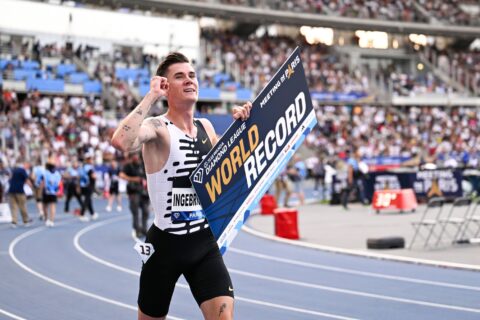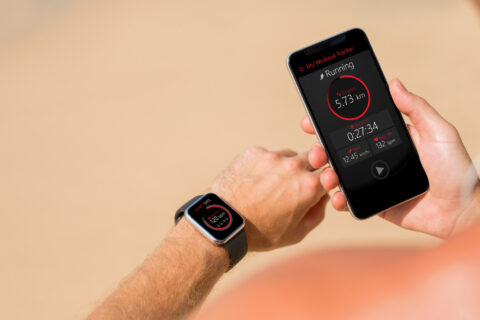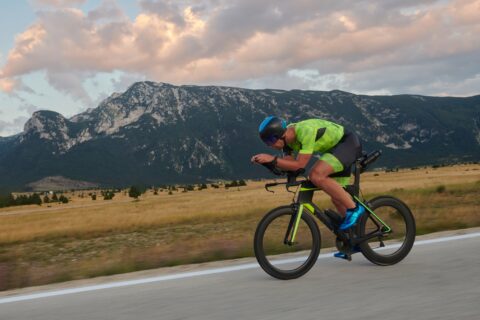In this workshop, Dr. Stephen Cheung examines the benefits of using Ratings of Perceived Exertion (RPE) in training, regardless of whether you use power meters, heart rate, or other metrics.
He starts by addressing the origins of RPE, developed by Dr. Gunnar Borg, a Swedish psychologist, and how the scale has been modified to accommodate for intuition.
RPE is dynamic—it changes depending on the length of the workout—and is meant to take into account all of your perceptions. Dr. Cheung explains why each of these aspects is critical to how RPE is used.
Finally, Dr. Cheung examines the Sessions of Ratings of Perceived Exertion (sRPE) concept, which is well correlated to internal training load, to understand the power of this perceptual scale. How can athletes develop an anchor to their perceptions so a 3 is always a 3 and a 7 is always a 7? Can sRPE help athletes avoid monotony and, therefore, overtraining? How can the sRPE scale be used to integrate off-the-bike workouts into overall training load?
Ultimately, Dr. Cheung argues that RPE/sRPE can help athletes simplify their perception of workouts and, therefore, aid in the quantification and tracking of training load.
Video Transcript
Chris Case 00:09
Welcome to fast health laboratories, your source for the science of endurance performance.
Concept of RPE
Dr. Stephen Cheung 00:20
Hello, welcome to fast talk labs. I’m Professor Stephen Chung, a senior research fellow in the Department of Kinesiology at Brock University in Canada. In today’s workshop, I want to talk about the concept of ratings of perceived exertion, or RPE will dig into a little bit of detail about the origins of the RPE perceptual scale, we’ll also take a look at the ability of this scale to potentially look at quantifying and tracking our training over the course of one particular workout, how hard it was, and also to track our training over long term. So the first question to ask is, what is the ratings perceived exertion scale? and Why are there two different ones? The original scale was developed by Professor Gunner Borg in the early 1960s. And it runs from six up to 20. Why is it kind of this weird value of six up to 20? That’s because Professor Borg was trying to look at a scale that can track with our internal strain, in this case, heart rate. And he found that there was a very strong relationship or tracking between our perception of effort and the heart rate itself. So at rest, many individuals have a resting heart rate of 660 beats per minute, and it corresponded to roughly about six, because you’re a complete rest. Now as the intensity of exercise got harder, let’s say to 13,
Dr. Stephen Cheung 02:00
that correlated very well with for many people a heart rate of about 130. And it goes all the way up to 20. Because most individuals, when they’re very fit and young have a max heart rate of 200. So there was this, again, fairly linear scale from six up to 20. perception that tracked very well linearly with heart rate going from rest of 60, up to a max of 20. It has also been modified to a scale of zero to 10. Because intuitively, that is a lot easier to understand for many people, unless your spinal tap and you crank it up to 11. Just for fun, but for most people, they can understand the concept of zero being the absolute easiest to 10 being as hard as you can. So you have two different scales. And the scale also comes with words to try to help you anchor your perception to the scale. So for example, on the six to 20 scale, it goes from seven being very, very light 13 being somewhat hard, 15 being hard, 17 being very hard 19 being very, very hard. Again, similarly, from zero to 10, there is a series of words that help you to anchor them. The other important thing to understand is that RPE is really meant to capture your whole body sensation, it is not meant to capture just how your legs are feeling at any one moment or how your lungs are breathing. It’s really about how the entire effort is feeling to your whole self at any one time. So as you use RPE during a particular workout, keep in mind that it is dynamic, so it does change over time. So if I asked you to ride at 200 watts, for the first minute, it might be an RPE on a scale of six to 20, it might be 10. But if now 30 minutes into it, this might now feel like 13 if you were to do this for four hours, that now might feel like 17 or 18 because you’re getting tired. So RPE does change obviously over time. It also changes if you are using RPE to track your effort. And that’s actually a very good way to, for example, do an endurance ride. If you or your coach wants you to do a ride at an easy endurance effort, you might set this perceptual scale of about 11 and you want to feel about that 11 over the course of the entire let’s say three hour ride, even if that means your power output is dropping as you fatigue. So it does change over time. So keep that in mind. And now the other thing I want to talk about is, can RPE be used to quantify not just a moment in time during a workout, but the entire workout itself? How hard was it? how intense was it? So in 1995, Professor Karl Foster University of Wisconsin first came up with this concept of using RPE to quantify how hard an entire workout with and he called this sessions RPE or SRP, and that is kind of a whole feeling of how was the entire workout? Both the warm up the actual ride itself or, or workout itself, and also the cool down? How did that Entire workout feel. And he mostly use the scale of zero to 10. But it can also be done with six to 20. The main thing is to keep it consistent as you use it. But for the rest of the talk, I’m going to talk about zero to 10, mostly. So the idea is you finished your workout and give yourself a little bit of time to recover so that you don’t necessarily just finish with a sprint and say, Oh, that was crazy hard, therefore the entire workout is nine. So do the entire effort. And then how does that feel? Give yourself again, typically, in the initial derivation of the SRP, they recommended about 30 minutes, so that you kind of have time to cool down and kind of digest how the entire workout was. And they found that people were pretty good worth correlating the perceived SRPE and their overall kind of internal training load, whether that was quantified with heart rate, or as time went on with power any other kind of objective or quantifiable metric. Then Dr. Foster went with the idea of Okay, can we then use it to quantify over our training load over a course of a week, a month, etc. So to do that he took each individual workout asked athletes to rate their SRPE. So let’s say it’s four, and you did it for 60 minutes for an hour. So your overall training load is then four times 60, or 240 units. So that’s how the original SRPE was developed again in 1995. And we’ll take now a look at some of the evidence for how to actually implement it, and how valid it is. So the first question is, does SRPE track well with an internal measure of efforts such as heart rate, and this is what is shown on the graph, so on the X or bottom axis is SRPE. And on the vertical or Y axis is percent of heart rate reserve. This was taken from a wide range of different tests and protocols on either treadmill or the bike. And it shows that there is a very strong correlation overall, between SRPE and actual percent of heart rate reserve. So this does show pretty good and strong tracking between your perception and this measure of internal load. We also see the same thing when we’re looking at SRPE track to lactate, another measure of internal load. This is again from a wide range of treadmill and cycling protocols. And looking at the final 10 minutes of effort. And lactate measures, again, very, very strong correlation and tracking between the two values. So this suggests that SRPE again, a feeling of how was the overall effort the entire workout seems to track pretty well with the actual internal load. So hopefully, this suggests that SRPE can be a pretty good tracking of how hard an effort is, or workout is. So then the question really comes back to Okay, there are two scales for RPE, a six to 20 scale, or a zero to 10 scale doesn’t really matter which one we use. And what this graph suggests is that no, it doesn’t really matter which one we use, they track very well between the 10 scale and a six to 20 scale. So the main thing is to be consistent, and use that one and one only, you’re going to get more comfortable with that particular scales. And just keep using the one that you feel is more intuitive to you. And just make sure you’re consistent. Keep using that. The other question then is does SRPE track with the duration of effort? I said earlier that RPE by itself, if you ask an individual during a ride, and you ask them multiple times RPE is going to change, so does a sessions RPE, again, the entire workout does that track with the duration of effort. This is a summary graph of different studies looking at SRPE and exercise at particular intensities, these same intensities for each individual line, but done for different durations. So for example, with this square the up at the top, we see that initially, the SRPE, if the effort was done for about 10 minutes, it felt around four. And then if it was done for about 20 minutes, that SRPE kind of went up to 5. 30 minutes went up to 6. 40 minutes and went up to about eight. So it was a pretty good linear tracking in all of these different studies for the same exercise intensity, but done at different effort, different durations over different days. So this suggests that for constant intensity exercise, there is a pretty linear tracking with duration, which is a good thing, we want the scale that can kind of track well with the overall effort. And obviously, a longer ride at a set intensity is going to be harder than a shorter ride. So I said earlier that SRPE originally was proposed to be best taken about 30 minutes after exercise. Because really, originally, the researchers came up with it, kind of after a workout, and then they got out of the shower and kind of said, wow, you know, that was hard, or Wow, that was pretty easy. So it was almost that kind of cool down and post shower feel. And the original ideas that again, it’s going to avoid that immediate, I did a sprint at the end of an hour easy writing, and that sprint made it feel like a nine instead of really, in reality, it was a three. So it avoided that endpoint effect. The other question is, you know, does it absolutely have to be at 30 minutes, and this graph suggests and this data suggests that no, SRPE is actually quite temporally robust. So it, it’s pretty constant over time, whether it was taken at 30 minutes, whether it was even the graph here doesn’t show whether it was taken almost immediately after,
Specific Efforts related to RPE
Dr. Stephen Cheung 12:49
In a workout. And also, whether it was taken over a day, three days, seven days, 10 days, even 14 days in this data after workout, there was very little kind of overall fluctuation. And how hard that effort kind of felt when people were reminded of that effort. So this suggests that even if you forget to take a measure 30 minutes, it’s still fine, you can still kind of get a good sense of it. Having said that, though, I still do feel that it’s probably best to make a note of it at a consistent time just to have more control and more consistency. So even though the data says you can take it, you know, almost any time, I still do think there is value in taking it at the same time, whether it’s 30 minutes or an hour, or whatever, just keep it consistent overall. So while we’re focused on the bike, I think one of the big values for us as cyclists, even though we have power meters, and we have heart rate monitors, we have lactate monitors we want to is to be able to track our off bike training. And so the big question for that is, for example, if we’re doing weights or core work or like to do a lot of rock climbing, you know, does it does the sessions RPE really track our training in those different environments. And this was a study that was done on different types of resistance training. One workout, for example, was purely focused on strength, another was focused on hypertrophy, and another on power. And this shows that there is pretty good separation between those three types of workouts in terms of the SRPE. And that is exactly what we want. We want us a perceived scale or any kind of scale that’s going to differentiate between an easy workout and a harder workout. So this is good support that SRPE can be used for things off the bike too. And really The SRP wasn’t necessarily just originally developed for running or cycling. It was also developed for team sports too. So the next question to ask is, if it does track well with different types of weight workout, does that also actually correlate with the equivalent in cycling with an endurance sport. And this data here of these two graphs suggests that there is pretty strong linkage between the two. So with the close circles, it is looking at cycling at three different exercise intensities from 50, up to 90% VO2 max or peak power output. And it is comparing that to three different intensities of weight workout. And it shows that there was again, pretty not just relative tracking between the two, but the absolute values are pretty close also. So it suggests that there’s good equivalency between say on bike work with off bike work. So now that we get an idea that SRPE is quite powerful, and valid, what can we do with the data, one of the big things that Professor Foster proposes that we can look at the idea of monotony, look at whether we’re doing the same kind of relative strain on our body day after day. And that is something that in general, we don’t want, because that’s going to lead to boredom, it’s going to lead to mental fatigue, and potentially overtraining. So we want the variety of workouts, we also want a variety of loads in our body, not just the same load day after day. So in this example, we see a seven day training plan of multiple exercises from cycling and jogging, and skating, more aerobic exercises to lifting and plyometrics. So a variety of exercises. And, again, what we see here is the training load on the far right of the table, which is, again, a combination or a function of the SRPE. So in the in the day one, it is four, and the time it was a three hour ride, so 180 minutes, so the overall training load was 720. So this is tracked over time. And what monotony is, is the daily average over the course of the week, divided by the standard deviation with a standard deviation being a measure of the variability. So if you have very little
sRPE and how to calculate
Dr. Stephen Cheung 17:42
variability, day to day, your monotony level is going to rise because your denominator is very small. So in this example, the monotony is pretty good because it is less than two and over a series of studies, that was kind of the threshold of two was the tipping point at which fatigue and boredom and potential overtraining was setting in. So we generally want a monotony level of less than two. So overall strained then is proposed by Professor foster to be the load. So in this case, it was over this week as 2340 multiplied by a factor of your monotony. So if you have a really high monotony, then your strain is going to be even higher. So in this example, the load is 2340, the monotony is 1.46. You multiply that together, and the overall strain on the body in the mind is 3416. So I found this to be a really useful tool. That’s something that we can take away whether we decide to use SRPE to track our training or even just with power or with heart rate. So let’s sum up. How do we actually use SRPE? I think the first important thing if we’re going to use SRP is really learn to anchor that perceptual scale, right? It’s not just flashing in front of you once and Okay, yeah, I got a sense of what zero and 10 over time you really going to develop a good cue for what is zero? What is a four? What is a six? How does a five differentiate from a six? How does that feel? And also what is the difference between an EIGHT and a NINE for example. So really train yourself and kind of don’t expect to be perfect at it right at the start. It’s going to evolve over time. And then you’re really going to become much more stable in your ability to differentiate between what is the three? What is the seven. would I only use it? I Don’t think we need to as cyclists because we do have power. And we do have heart rate. We have all sorts of training software dedicated to us. So I don’t think we need to throw those away and just use SRP. But I think there are ways that we can use it. And I would certainly, in your training log, I would suggest every day just putting down a value for how hard that entire workout felt. So just make a note of it every day SRPE equals four, SRPE equals six, for example. And that’s going to, as you go back through your training log in to give you a sense of how hard an overall workout is. So I think that’s valuable. I think the other thing that we can do as as cyclists is to really use SRPE for times when we don’t have access to power or we don’t have access to heart rate. So whether we’re doing a, a weightlifting effort, whether we are going rock climbing in my case, or going snowboarding, you know, to really track your overall training in terms of how that load feels. And to supplement that I know for myself, I have a good sense of, for example, if I’m doing a, an easy climbing day, I know you know, kind of roughly how much training load that gives me and because I can reverse engineer based on my SRPE. Similarly, if I’m going for a really power kind of interval day in terms of climbing, I give myself a different amount of load, because I know the SRPE is much higher, even if the time is the same. And then the other thing I think we can really use SRPE for is really, whether we use it with our power or your heart rate files, get this idea of monotony, and the overtraining tracking. If you’re using TSS or Xs s, you can get a good sense of your daily load and get an idea of whether you are just doing the same thing day after day putting the same load on your body doing the same kind of workout. So I think, whether we use SRP to calculate monotony, I think it has a lot of importance as a tracking parameter for overall training program, even if we’re using power or heart rate. So what’s been your experience with kind of perceiving how hard or easy your workout is? Join the conversation on fast talk forums,
Dr. Stephen Cheung 22:41
and let us know your experience do you think SRPE is valuable? And what has been your experience with it? I’m Professor Steven Cheung. Thanks for watching. We’ll see you next time.



